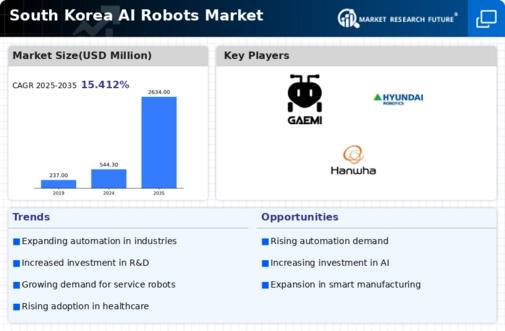The ai robots market in South Korea is characterized by a dynamic competitive landscape, driven by rapid technological advancements and increasing demand across various sectors, including manufacturing, healthcare, and logistics. Major players such as Boston Dynamics (US), ABB (CH), and SoftBank Robotics (JP) are at the forefront, each adopting distinct strategies to enhance their market positioning. Boston Dynamics (US) focuses on innovation, particularly in mobility and agility, which allows its robots to perform complex tasks in diverse environments. ABB (CH) emphasizes automation and digital transformation, integrating AI into its robotic solutions to optimize manufacturing processes. Meanwhile, SoftBank Robotics (JP) leverages partnerships and collaborations to expand its reach in the service robotics sector, particularly in hospitality and healthcare, thereby shaping a competitive environment that prioritizes technological prowess and strategic alliances.
Key business tactics within this market include localizing manufacturing and optimizing supply chains to enhance efficiency and reduce costs. The competitive structure appears moderately fragmented, with several key players exerting influence over specific niches. This fragmentation allows for a variety of innovative solutions to emerge, as companies strive to differentiate themselves through unique offerings and specialized capabilities. The collective influence of these players fosters a competitive atmosphere where agility and responsiveness to market demands are paramount.
In October 2025, Boston Dynamics (US) announced a partnership with a leading logistics firm to deploy its Spot robots for warehouse automation. This strategic move is likely to enhance operational efficiency and reduce labor costs, positioning Boston Dynamics as a key player in the logistics sector. The integration of Spot robots into existing workflows may also serve as a benchmark for future automation solutions, indicating a shift towards more intelligent and adaptable robotic systems.
In September 2025, ABB (CH) unveiled its latest AI-driven robotic arm designed for precision manufacturing. This development underscores ABB's commitment to innovation and its focus on enhancing productivity in manufacturing environments. The introduction of this advanced robotic arm is expected to attract significant interest from manufacturers seeking to improve their operational capabilities, thereby reinforcing ABB's competitive edge in the market.
In August 2025, SoftBank Robotics (JP) launched a new service robot tailored for the healthcare sector, aimed at assisting medical staff in hospitals. This initiative reflects SoftBank's strategic focus on addressing the growing demand for automation in healthcare, particularly in patient care and administrative tasks. By positioning itself in this critical sector, SoftBank Robotics is likely to enhance its market presence and drive further adoption of robotic solutions in healthcare settings.
As of November 2025, current competitive trends in the ai robots market are heavily influenced by digitalization, sustainability, and the integration of AI technologies. Strategic alliances are increasingly shaping the landscape, as companies recognize the value of collaboration in driving innovation and expanding market reach. Looking ahead, competitive differentiation is expected to evolve, with a notable shift from price-based competition towards a focus on innovation, technological advancements, and supply chain reliability. This transition may redefine how companies position themselves in the market, emphasizing the importance of developing cutting-edge solutions that meet the evolving needs of consumers.














Leave a Comment